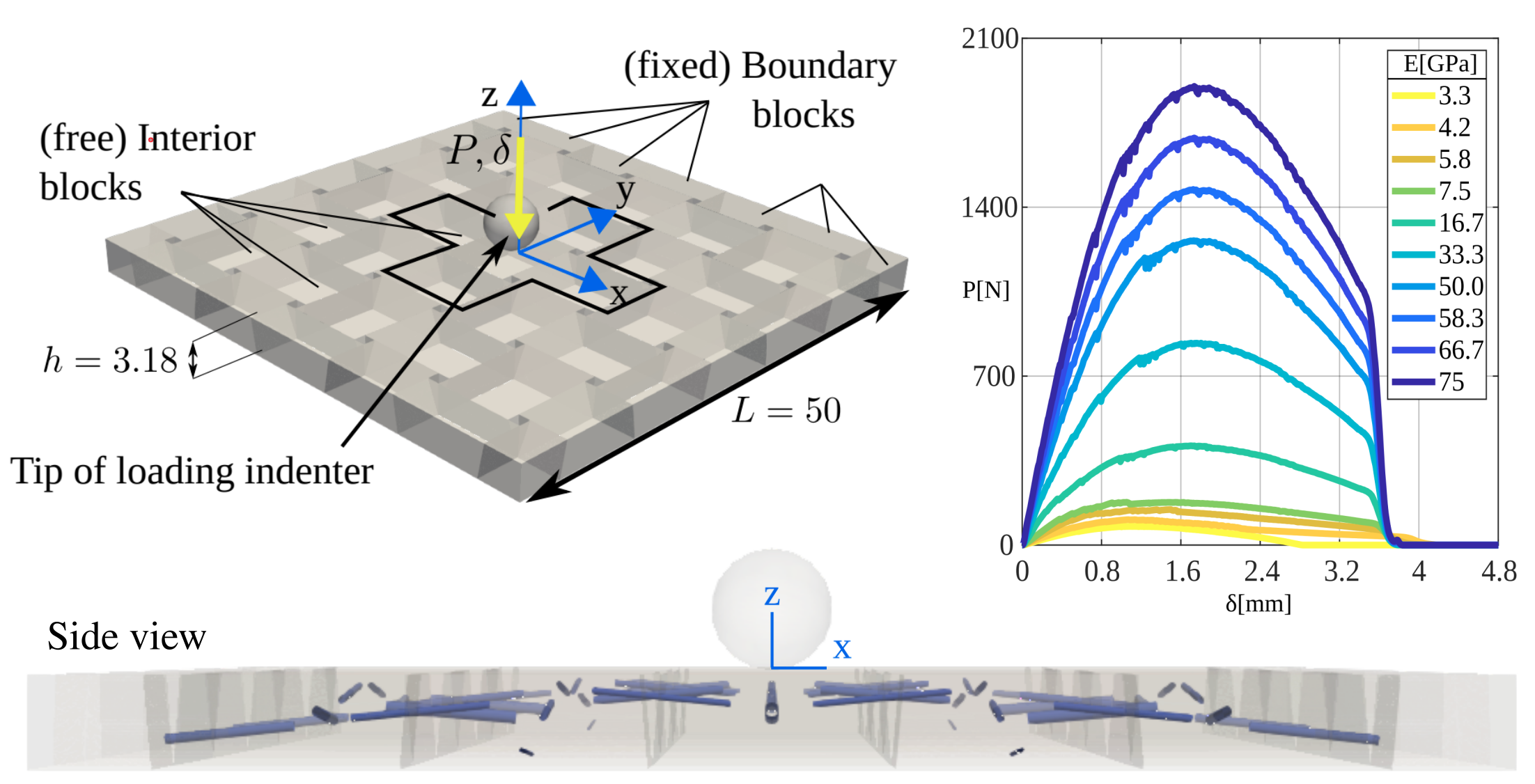Failure of Topologically Interlocked Structures
 Topological Interlocking Structures (TIS) are assemblies of interlocking building blocks that hold together solely through contact and friction at the blocks' interfaces, and thus do not require any connective elements. This salient feature makes them highly energy-absorbing, resistant to crack propagation, geometrically versatile, and re-usable. It also gives rise to failure mechanisms that, differently from ordinary structures, are governed by multiple contact interactions between blocks and frictional slip at their interfaces. Commonly-used modeling tools for structural analysis severely struggle to capture and quantify these unusual failure mechanisms. Here, we propose a different approach that is well suited to model the complex failure of TIS. It is based on the Level-Set-Discrete-Element-Method, originally developed for granular mechanics applications. After introducing the basic assumptions and theoretical concepts underlying our model, we show that it well-captures experimentally observed slip-governed failure in TIS slabs and that it estimates the force-displacement curves better than presently available modeling tools. The theoretical foundation together with the results of this study provide a proof-of-concept for our new approach and point to its potential to improve our ability to model and to understand the behavior of interlocked structural forms.
Topological Interlocking Structures (TIS) are assemblies of interlocking building blocks that hold together solely through contact and friction at the blocks' interfaces, and thus do not require any connective elements. This salient feature makes them highly energy-absorbing, resistant to crack propagation, geometrically versatile, and re-usable. It also gives rise to failure mechanisms that, differently from ordinary structures, are governed by multiple contact interactions between blocks and frictional slip at their interfaces. Commonly-used modeling tools for structural analysis severely struggle to capture and quantify these unusual failure mechanisms. Here, we propose a different approach that is well suited to model the complex failure of TIS. It is based on the Level-Set-Discrete-Element-Method, originally developed for granular mechanics applications. After introducing the basic assumptions and theoretical concepts underlying our model, we show that it well-captures experimentally observed slip-governed failure in TIS slabs and that it estimates the force-displacement curves better than presently available modeling tools. The theoretical foundation together with the results of this study provide a proof-of-concept for our new approach and point to its potential to improve our ability to model and to understand the behavior of interlocked structural forms.  Topological Interlocking Structures (TIS) are assemblies of interlocking building blocks that hold together solely through contact and friction at the blocks' interfaces, and thus do not require any connective elements. This salient feature makes them highly energy-absorbing, resistant to crack propagation, geometrically versatile, and re-usable. It also gives rise to failure mechanisms that, differently from ordinary structures, are governed by multiple contact interactions between blocks and frictional slip at their interfaces. Commonly-used modeling tools for structural analysis severely struggle to capture and quantify these unusual failure mechanisms. Here, we propose a different approach that is well suited to model the complex failure of TIS. It is based on the Level-Set-Discrete-Element-Method, originally developed for granular mechanics applications. After introducing the basic assumptions and theoretical concepts underlying our model, we show that it well-captures experimentally observed slip-governed failure in TIS slabs and that it estimates the force-displacement curves better than presently available modeling tools. The theoretical foundation together with the results of this study provide a proof-of-concept for our new approach and point to its potential to improve our ability to model and to understand the behavior of interlocked structural forms.
Topological Interlocking Structures (TIS) are assemblies of interlocking building blocks that hold together solely through contact and friction at the blocks' interfaces, and thus do not require any connective elements. This salient feature makes them highly energy-absorbing, resistant to crack propagation, geometrically versatile, and re-usable. It also gives rise to failure mechanisms that, differently from ordinary structures, are governed by multiple contact interactions between blocks and frictional slip at their interfaces. Commonly-used modeling tools for structural analysis severely struggle to capture and quantify these unusual failure mechanisms. Here, we propose a different approach that is well suited to model the complex failure of TIS. It is based on the Level-Set-Discrete-Element-Method, originally developed for granular mechanics applications. After introducing the basic assumptions and theoretical concepts underlying our model, we show that it well-captures experimentally observed slip-governed failure in TIS slabs and that it estimates the force-displacement curves better than presently available modeling tools. The theoretical foundation together with the results of this study provide a proof-of-concept for our new approach and point to its potential to improve our ability to model and to understand the behavior of interlocked structural forms. 